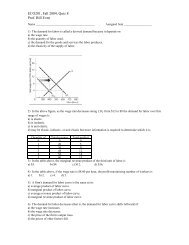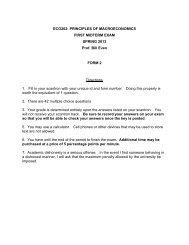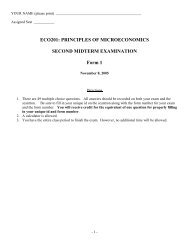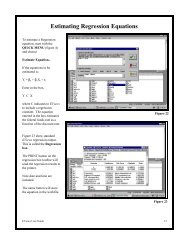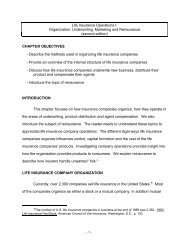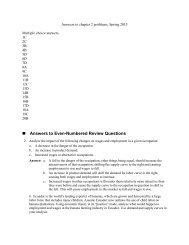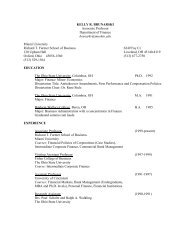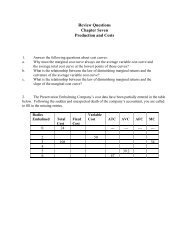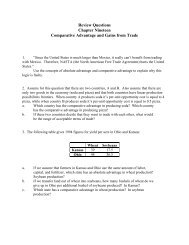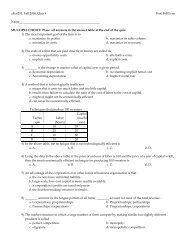Quiz 4
Quiz 4
Quiz 4
You also want an ePaper? Increase the reach of your titles
YUMPU automatically turns print PDFs into web optimized ePapers that Google loves.
Eco201, <strong>Quiz</strong> 4, Fall 2005Prof. Bill EvenName _____________________1) An implicit cost is an opportunity cost thatA) requires no actual payment of cash.B) is actually part of the firm's normal profit.C) is measured by the amount of cash the firm actuallypays out.D) is adjusted for the rate of inflation.2) The difference between the market price of a new carused by a firm and the market price of the same car oneyear later is known asA) economic depreciation.B) physical deterioration.C) economic deterioration.D) physical depreciation.3) If economic profits are equal to zero thenA) its profits as measured by accountants must be lessthan zero.B) below normal profits are being earned.C) its profits as measured by accountants must also beequal to zero.D) normal profits are being earned.Techniques that produce 100 sweatersTechnique Labor(hours)Capital(machines)A1035B2525C1060D30204) In the above table, the technique that is nottechnologically efficient isA) A. B) B. C) C. D) D.5) Using the data in the above table, if the price of anhour of labor is $10 and the price of a unit of capital is$20, then the most economically efficient technique forproducing 100 sweaters isA) A. B) B. C) C. D) D.6) An advantage of the corporation over other forms ofbusiness organization is thatA) large-scale, low-cost capital is more readily available.B) a corporation's profits are taxed only once.C) the owners have unlimited liability.D) the decision-making structure is simple.7) Where large amounts of capital are used, the dominantform of business organization is theA) nonprofit corporation B) corporation.C) is the proprietorship. D) is the partnership.8) Under ________, there are many firms selling slightlydifferent products.A) perfect competition B) monopolistic competitionC) monopoly D) oligopoly9) The air travel market, which is dominated by a fewlarge firms, is an example of a(n)A) perfectly competitive market.B) oligopolistic market.C) monopolistically competitive market.D) monopoly market.10) The ________ the Herfindahl-Hirschman Index(HHI), the ________ the industry.A) lower; less competitive B) higher; lesscompetitiveC) higher; more firms in D) lower; more profitable11) Total revenue minus the sum of implicit and explicitcosts is equal to ________ profit.A) opportunity B) normalC) entrepreneurial D) economic12) If 10 firms share the sales of the market equally, thefour-firm concentration ratio is ________ percent and theHerfindahl-Hirschmann index is A) 10; 1000B) 100; 500 C) 40; 1000 D)none of the above.13) The short run is a period of time in whichA) the amount of output is fixed.B) nothing the firm does can be altered.C) the quantities of some resources the firm uses arefixed.D) prices and wages are fixed.Labor Total product Marginal Averag(workers perday)0(units per day)0product0eproduct012 2 22831214) In the above table, the marginal product of the thirdworker isA) 1. B) 3. C) 2. D) 4.15) In the above table, the average product of threeworkers isA) 4. B) 2. C) 1. D) 3.Assigned Seat___________
Eco201, <strong>Quiz</strong> 4, Fall 2005Prof. Bill Even20) The above table shows some cost data for Tracey'sTents. What is the marginal cost of the 3rd tent?A) $70 B) $120 C) $20 D) $2521) The above table shows some cost data for Tracey'sTents. What is the average total cost when output is 3?A) $50 B) $120 C) $40 D) $3022) A firm's marginal cost is $82, its average total cost is$50, and its output is 800 units. Its total cost of producing801 units isA) less than $40,000. B) between $40,050 and $40,080.C) between $40,000 and $40,050. D) greater than$40,080.16) In the figure above, the marginal product of thesecond worker isA) 5 units. B) 1 units. C) 2 units. D) 10 units.23) The marginal cost (MC) curve intersects theA) ATC and AFC curves at their minimum points.B) ATC and AVC curves at their minimum points.C) AVC and AFC curves at their minimum points.D) ATC, AVC, and AFC curves at their minimum points.17) At point d in the above figure, the average product oflabor equalsA) 15. B) 3.75.C) 4. D) approximately 1.18) The law of diminishing returns states that asA) a firm uses more of a variable input, given thequantity of fixed inputs, the firm's average total cost willdecrease eventually.B) the size of a plant increases, the firm's fixed costdecreases.C) the size of a plant increases, the firm's fixed costincreases.D) a firm uses more of a variable input, given thequantity of fixed inputs, the marginal product of thevariable input eventually diminishes.19) If a firm's marginal product of labor is less than itsaverage product of labor, then an increase in the quantityof labor it employs definitely willA) decrease its total product.B) not change its average product of labor.C) decrease its average product of labor.D) increase its marginal product of labor.Output(tents)01234Totalfixed cost(dollars)5050505050Totalvariable cost(dollars)0254570115Total cost(dollars)50759512016524) The average total cost curves for plants A, B, C andD are shown in the above figure. Which plant is best touse to produce 20 units per day?A) plant A B) plant B C) plant C D) plant D25) Economies of scale refer toA) the range of output over which the long-run averagecost falls as output increases.B) a feature of short-run production functions but notlong-run production functions.C) the point at which marginal cost equals average cost.D) the fact that in the long run, fixed costs remainconstant as output increases.1a 2a 3d 4c 5d 6a 7b 8b 9b10b19c11d20d12c21c13c22d14d23b15a24a16a25a17b18d



